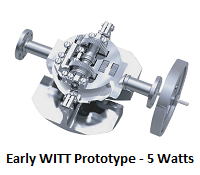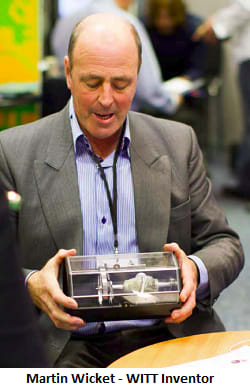Is this the Energy Harvesting breakthrough the World's been waiting for?
Follow articleHow do you feel about this article? Help us to provide better content for you.
Thank you! Your feedback has been received.
There was a problem submitting your feedback, please try again later.
What do you think of this article?
A lot of movement goes to waste. A bob up and down, a wobble from side to side or a twist or turn, often means energy is lost.
Imagine if we could harness this wasted energy and produce electricity– if we could charge our phones while we walk, use the continual motion of the seas to power lights on beacon buoys or even provide power in remote areas.
Harnessing movement for electricity generation is not new - water turbines, dynamos and even some watches take advantage of kinetic movement and turn it into electrical energy.
However, all of these only harness movement in one direction.
Last week I got to play with a prototype of the new WITT device – a device that can harvest chaotic movement from six degrees of motion into electrical energy.
Initially I thought this idea was a little bonkers, but having now seen and played with it, I am very excited about the possibilities and look forward to seeing a production model. It was mesmerising and fun to play with, as you may be able to tell from my video!
The heavy pendulum drives a transmission system - converting any combination of motion into a one-directional rotation of a flywheel which can be coupled to a generator to produce electricity.
- The more motion there is, the more power it can generate.
- The heavier the pendulum, the more power can be harnessed.
- Kinetic energy is harvested – potential energy is not.
- Gears - maximum of about 20, minimum of 13, in the transmission.
- Contains four one-way clutches.
- Fastest input will drive the output – not combined.
- Power taken from the transmission needs to be controlled or the whole system could stall.
- Largest possible – “meters” for mechanical transmissions – hydraulic designs could be larger.
- Smallest possible - “15mm transmission” at present, based on existing mechanism.
- Self winding watches only convert motion from one plane
- Paper on the concept
I also got a chance to chat with the inventor, civil engineer Martin Wicket - if you have any further questions that I didn’t cover, please do add them in the comment section below.
“WITT technology is able to comfortably gather double the amount of power than any other comparable technology currently available.” - Martin Wickett, Inventor
The idea originated when Martin looked at the treadle system on old bicycles –and then he put two treadle systems together. It progressed from there. To get from the idea to a product, in 2011 he made a prototype from plumbing parts and plywood. He then approached a small engineering firm to help make the first proper prototype.
There have been six prototypes so far - concentrating on efficiency and how the whole transmission system goes together – on a low budget. The efficiency and life expectancy of the gears and bearings have also been a key point in the design – Martin wants this to be a “setup and leave” energy harvesting device.
Inside the transmission are a whole lot of gears and four one-way clutches – the same system that allows you to freewheel on a bicycle. Self winding watches are similar in some ways, but only convert motion from one plane, and they have really small pendulums – they do not need to produce much power.
“WITT can harvest the full six degrees of motion - tapping into the kinetic energy which can be generated from clockwise, anti-clockwise, back and forth, and up and down motion.” - Martin Wickett, Inventor
I was curious about the harnessing “up and down” when using pendulums - Martin said “As the pendulums need to hang down, we can’t harness z motion directly, but combining with either x or y, you can collect energy from the z, by combining the two different motions.”
My initial thought for this was for powering phones from my own daily movement, or animal trackers from theirs. Martin and his team currently think the smallest they can go at the moment is a transmission of 15mm across – definitely small enough to put in a pocket or collar.
However, WITT Ltd’s first commercial product will be a 200W marine unit - ready for Autumn 2017. Smaller units for other applications will be developed alongside, subject to investment.
Talking about taking the idea from paper to product, Martin said “We realised from the start we had to go through a methodical process – a feasibility study, check nothing else similar was already available, engage with industrial partners to ensure we could make a mechanical product rather than concept. It’s a slow process. A lot of people can’t do everything – networking, communication and engineering – so you need to get the right team to work together.”
He added “By having a prototype – something tactile, something you could pick up, has been the only way to get publicity. Without the prototypes we would never have been able to convince anyone we had anything. We now have interest from quite a few engineering companies".
I asked what the main differences he had found between civil engineering (his background) and mechanical – “Civil engineering is quite static, whereas here I had to start looking at dynamic situations and stresses and forces in a dynamic environment – you couldn’t just come up with one good idea, you had to come up with another one afterwards.”
A few videos have been created to help create awareness of the device, including this winning Ocean Exchange video created by students at Savannah College of Art & Design
Admiral Sir James Burnell-Nugent KCB CBE was recently appointed as chairman of WITT Limited.
“The WITT is the most exciting new development in renewable energy since the invention of the solar panel. There is movement all around us and being able to convert energy from that movement into usable electric power is a truly groundbreaking development. The constant movement of the sea means that WITT’s pioneering technology has immediate applications in the maritime sector”
He added;
“The technology is remarkable, the opportunities unbounded, the potential as great as one’s imagination and the journey that lies ahead a truly exciting investment opportunity.”
And it’s obviously not just their Chairman that thinks so – WITT Ltd. raised £300,000 in the first three days of their Crowdfunding campaign – the campaign is open until 5th April, 2016. a few weks later, almost £2M has been raised!
How to Invest
More details and opportunities to invest on their Crowdcube project page.
Follow WITT on Social Media.
- Facebook - Witt-energy
- Twitter - @WITTEnergy
- LinkedIn - LinkedIn Page
With almost 80 years of experience working with engineers, here's what RS Components think of the WITT.
Video Credit - Tripleworks Productions
What do you think of the WITT?, What would use one for? Add a comment and let us know what your thoughts!
About Lucy -
Dr Lucy Rogers is a maker and tinkerer, as well as being a Chartered Mechanical Engineer. Her independent company Makertorium Limited, is a problem solving consultancy. From calculating the probability of spacecraft being hit by space debris, to hacking robot dinosaurs at a theme park.







Comments